
Station Name: BARCOMBE
To see other stations on the Bluebell Line click on the station name: West Hoathly Barcombe Gallery 1 c1905 - c1910
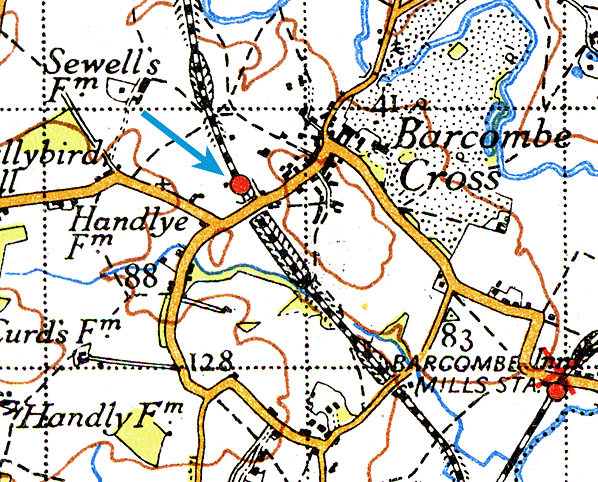 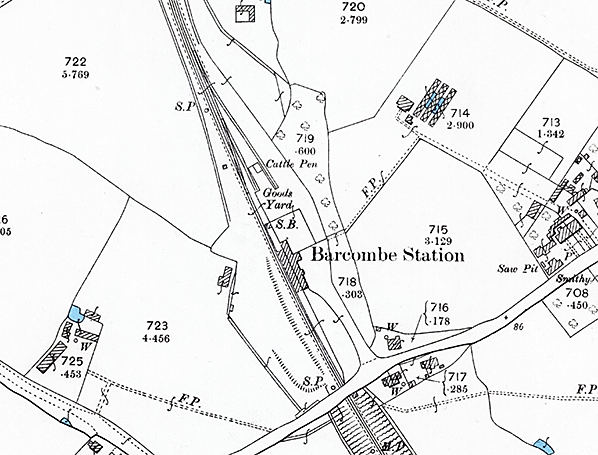
1899 1:2,500 OS map shows the layout of Barcombe station after the goods yard was provided in 1897. The layout remained the same until closure. The station was provided with a single platform on the down side of the line. The goods yard, also on the down side comprised two sidings running either side of a cattle dock at the north end of the platform. A small livestock pen was provided on the dock. A signal box was sited at the north end of the platform.
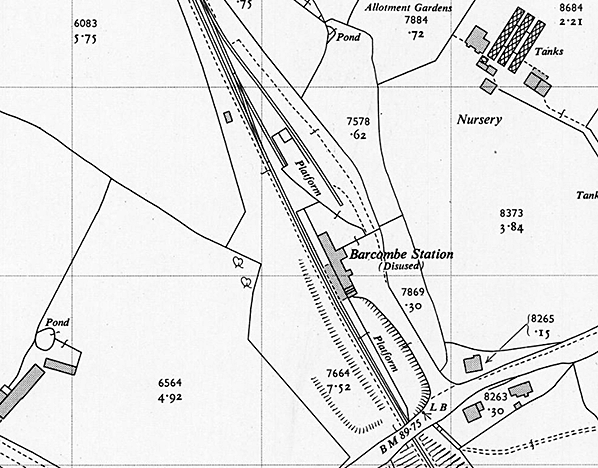
1956 1:2,500 OS map. The station was closed to all traffic in 1955 and is therefore shown as 'disused' The line into Lewes was reopened temporarily in August 1956 but Barcombe station remained open to all traffic. The signal box was abolished in 1931 and has been demolished. Both the passenger platform and cattle dock are identified as 'platform'.
c1905)old2.jpg) A postcard view from the common vantage point of the road bridge, circa 1905. The usual milk churns are present and, unusually some people. On close examination, however, some of the people are railway staff while the man with two young boys with the churns may suggest a train is due soon. A feature of note in early photographs is the clean ballast along with the seemingly ever-present pile of ballast visible beyond the signal box. A signal wire run can be seen in the foreground parallel to the track. These wires would have operated Barcombe's Down Starter and Up Home signals, the latter being located south of the bridge. Barcombe box was, however, not a Block Post and with the infrequent train service it was a relatively simple abolition when the Southern Railway decided to do so in 1931.
Copyright photo from John Alsop collection c1905)old3.jpg)
Another view, undated but probably c1905, looking north-east at the station. On this occasion there was some activity with passengers waiting beneath the canopy and what appears to be quantity of luggage. As always for the time, milk churns are also present. Note that the fencing has become dilapidated although no doubt repairs would have been undertaken from time to time. At extreme left a train can be seen approaching the station. It is somewhat unfortunate that only part of the locomotive can be seen as it's full headcode display is out of view. Nevertheless it can be seen to be carrying a diamond plate on the left hand end of its bufferbeam. Headcode arrays changed from time to time as needs dictated but it is known that for the East Grinstead - Lewes line the use of a diamond at the position seen here ceased in 1917. This, therefore, would indicated the latest year in which the photograph could have been taken.
Copyright photo from John Alsop collection c1905)old4.jpg)
Another view thought to date from the early twentieth century with, of course, the ever-present milk churns but this time in abundance. Compared to the circa 1905 postcard view some differences are evident. The bushes at the rear of the platform are more neatly tended in this view while different advertisements can be seen fixed to the fence. Some people are present beneath the near end of the canopy while a horse and trap waits patiently on the forecourt.
Copyright photo from John Alsop collection old7.jpg) A Down passenger train arrives at Barcombe headed by Class D3 0-4-4T No. 386. As usual there are more staff than passengers on the platform and even then the boy was probably the son of a staff member who perhaps also owned the dog. The train comprises a 7-set, likely all four-wheeled, with a brake at each end and the practice of providing two brakes remained the norm, for hauled stock, until well into the British Rail era. Locomotive No. 386 had been new to traffic in January 1894. She was named 'Chichester' until the 1906 de-naming policy took effect and while there is no obvious evidence of the name, this photograph is thought to date from around that time. As an appropriate, for the East Grinstead - Culver Junction line, aside No. 378 had been named 'Horsted Keynes'. No. 386 was to live on into British Railways days, becoming No. 32386 until withdrawn in 1952. A Down passenger train arrives at Barcombe headed by Class D3 0-4-4T No. 386. As usual there are more staff than passengers on the platform and even then the boy was probably the son of a staff member who perhaps also owned the dog. The train comprises a 7-set, likely all four-wheeled, with a brake at each end and the practice of providing two brakes remained the norm, for hauled stock, until well into the British Rail era. Locomotive No. 386 had been new to traffic in January 1894. She was named 'Chichester' until the 1906 de-naming policy took effect and while there is no obvious evidence of the name, this photograph is thought to date from around that time. As an appropriate, for the East Grinstead - Culver Junction line, aside No. 378 had been named 'Horsted Keynes'. No. 386 was to live on into British Railways days, becoming No. 32386 until withdrawn in 1952.Photo from John Mann collection old8.jpg) In this undated view Stroudley A1 Class No. 673 poses for the camera, along with a crew member and the boy on the platform who seem determined not to miss out. Two men can be seen in the gloom beneath the canopy and at least one is a staff member. Period advertisements can be seen, among which are the ubiquitous Pears Soap and Mazawattee Tea examples. The carriage is one of the famous LB&SCR 'Balloon' types and appears to be one of those built in 1907 as Push - Pull Brake Thirds. Initially they commonly worked solo with a suitably fitted A1/A1x 'Terrier' locomotive but this view does not appear to show a Push - Pull working. It has not been possible to identify the working by the headcode display on the locomotive, the crossed disc and the lamps, so it may have been some form of special. The locomotive is of particular interest. She carries the dark umber livery and lettering style in vogue during the 1905 - 1911 period and had been named 'Deptford' prior to the 1906 de-naming policy. In 1912 she was modified to Class A1x and in 1919 was sold to the Edge Hill Light Railway, Warwickshire, where she became No. 1 to be followed in July 1920 by unmodified sister No. 674, once named 'Shadwell' which became No. 2. Both exiled locomotives were officially withdrawn and scrapped in 1946 but in reality both had stood effectively derelict for some twenty years. The curious story of the Edge Hill Light Railway and its locomotives is well worth reading and plenty of information is available online and in books.
Photo from John Mann collection 9.jpg)
A view of Barcombe facing toward Culver Junction and Lewes. The locomotive is D3 class 0-4-4T No. 373. The livery of the rolling stock, apparently all-over umber, suggests the period is no earlier than 1910 . The train comprises a mix of six, eight and, it would appear, four wheeled vehicles. There is of course a brake vehicle at each end. A reasonable view of the signal box is offered, with its small nameboard mounted above the central window. The signal box roof has ornate ridging but to a different style to that on the roof of the station building.. On the platform are a young boy and three members of staff, one, third from right, very likely being the stationmaster. Locomotive No. 373 was new in December 1892 and to a design by Robert Billinton. The class was at one point in its life named with No. 373 carrying the name 'Billingshurst'. Names were painted onto the tanks in true 'Brighton' fashion but it is unclear in this photograph if the name was present. Following the 1923 Grouping the Southern Railway initially renumbered the locomotive to B373 and then to 2373. She survived into British Railways days and was allocated the BR number 32373 but it was never carried as she was withdrawn, from Horsham shed, in November 1948. This photo was also used for a colourised postcard.
Copyright photo from John Alsop collection Click here for Barcombe Gallery 2 c1910 - 1965
 Home Page Home Page
|
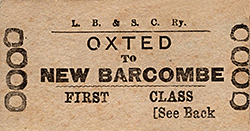 Barcombe was one of a series of fine LBSCR stations on the East Grinstead - Lewes line, which can be enjoyed in their refurbished state at Kingscote, Horsted Keynes and Sheffield Park on the Bluebell Line. Considering the small communities that they served, these stations were of remarkably generous proportions and elaborate design. The architect was T H Myers of Preston who used the 'Domestic Revival' style which was fashionable in the design of more expensive suburban villas.
Barcombe was one of a series of fine LBSCR stations on the East Grinstead - Lewes line, which can be enjoyed in their refurbished state at Kingscote, Horsted Keynes and Sheffield Park on the Bluebell Line. Considering the small communities that they served, these stations were of remarkably generous proportions and elaborate design. The architect was T H Myers of Preston who used the 'Domestic Revival' style which was fashionable in the design of more expensive suburban villas.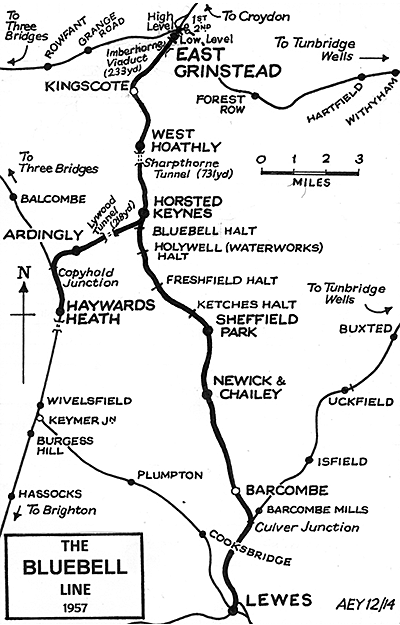 The central section of Barcombe station, which included the station master’s house, was a two-storey villa in red brick with red tiles on the upper storey - a traditional East Sussex feature - enlivened by broad bands of fish-scale tiles. The roof, also of red tiles, was enhanced by ridge cresting and substantial chimneystacks. Single-storey wings extended along the platform in both directions, also in red brick under hipped, tiled roofs; that at the north end housed the lamp room. On the platform and roadside gable elevations the upper storey was jettied (carried slightly beyond the lower storey) and the window in each gable also projected a little way, supported by scrolls and topped with a tiny, sloping tiled roof. Some of the ground-floor windows were mullioned. The use of curved eaves mouldings gave added interest to the building. The building was entered through a splendid wooden porch in the style of a lychgate. Hipped platform roofing provided shelter, extending to the platform edge. The single storey south end of the building with a flat roof housed the toilets.
The central section of Barcombe station, which included the station master’s house, was a two-storey villa in red brick with red tiles on the upper storey - a traditional East Sussex feature - enlivened by broad bands of fish-scale tiles. The roof, also of red tiles, was enhanced by ridge cresting and substantial chimneystacks. Single-storey wings extended along the platform in both directions, also in red brick under hipped, tiled roofs; that at the north end housed the lamp room. On the platform and roadside gable elevations the upper storey was jettied (carried slightly beyond the lower storey) and the window in each gable also projected a little way, supported by scrolls and topped with a tiny, sloping tiled roof. Some of the ground-floor windows were mullioned. The use of curved eaves mouldings gave added interest to the building. The building was entered through a splendid wooden porch in the style of a lychgate. Hipped platform roofing provided shelter, extending to the platform edge. The single storey south end of the building with a flat roof housed the toilets.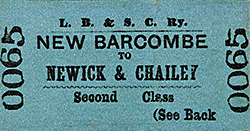 Initially, Barcombe didn't have any goods facilities but a small goods yard was provided in 1897 at a cost of £1450. The yard comprised a loop siding and head shunt on the down side to the north of the station. This allowed trains from either direction to enter the yard easily. From the loop, two short sidings ran either side of a small cattle dock. A timber fenced livestock pen was provided on the dock. The yard had no other buildings and was accessed from the station forecourt. A signal box was provided at the north end of the platform. Barcombe box was, however, not a Block Post and with the infrequent train service it was a relatively simple abolition when the Southern Railway decided to do so. The box was abolished on 8 June 1931 and replaced by a ground frame.
Initially, Barcombe didn't have any goods facilities but a small goods yard was provided in 1897 at a cost of £1450. The yard comprised a loop siding and head shunt on the down side to the north of the station. This allowed trains from either direction to enter the yard easily. From the loop, two short sidings ran either side of a small cattle dock. A timber fenced livestock pen was provided on the dock. The yard had no other buildings and was accessed from the station forecourt. A signal box was provided at the north end of the platform. Barcombe box was, however, not a Block Post and with the infrequent train service it was a relatively simple abolition when the Southern Railway decided to do so. The box was abolished on 8 June 1931 and replaced by a ground frame.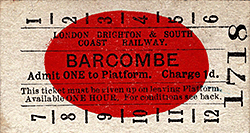 After Parliament repealed the sections in question, the line was closed in March 1958 and the track was lifted in 1960 from south of Sheffield Park to Culver Junction. Barcombe station was boarded up and although never vandalised the station became heavily overgrown and the condition of the building began to deteriorate during more than 20 years of disuse. During the late 1960s and through the 1970s a number of lorries belonging to JW Turner a haulage contractor from Chailey were seen parked on the station forecourt. These may have had no connection with the station building or perhaps part of the building was rented to JW Turner as an office. At one time a caravan was parked at the end of the platform.
After Parliament repealed the sections in question, the line was closed in March 1958 and the track was lifted in 1960 from south of Sheffield Park to Culver Junction. Barcombe station was boarded up and although never vandalised the station became heavily overgrown and the condition of the building began to deteriorate during more than 20 years of disuse. During the late 1960s and through the 1970s a number of lorries belonging to JW Turner a haulage contractor from Chailey were seen parked on the station forecourt. These may have had no connection with the station building or perhaps part of the building was rented to JW Turner as an office. At one time a caravan was parked at the end of the platform.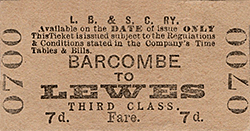 The line had six stations, but only Barcombe was within walking distance of a village. Chailey parish had two stations, one at Sheffield Park and the other at Newick and Chailey. It was customary for a rural line supported by a company or individuals to have stations close to the residences of its sponsors. Thus Sheffield Park station was built for the Earl of Sheffield, and Newick and Chailey for Newick Park and Reedens, the homes of two other sponsors. The other stations were at Kingscote, West Hoathly and Horsted Keynes. A branch ran from a junction at Horsted Keynes to Ardingly and Haywards Heath on the LB&SCR main line.
The line had six stations, but only Barcombe was within walking distance of a village. Chailey parish had two stations, one at Sheffield Park and the other at Newick and Chailey. It was customary for a rural line supported by a company or individuals to have stations close to the residences of its sponsors. Thus Sheffield Park station was built for the Earl of Sheffield, and Newick and Chailey for Newick Park and Reedens, the homes of two other sponsors. The other stations were at Kingscote, West Hoathly and Horsted Keynes. A branch ran from a junction at Horsted Keynes to Ardingly and Haywards Heath on the LB&SCR main line. 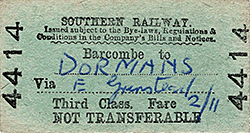 In 1954, long before the Beeching Axe, the branch line committee of British Railways proposed closing the line from East Grinstead to Culver Junction near Lewes. This was challenged by local residents, but closure was agreed in February 1955 for 15 June 1955, although the line closed on 29 May due to a rail strike An acrimonious battle between British Railways and the users of the Bluebell Line then ensued, and lasted three years.
In 1954, long before the Beeching Axe, the branch line committee of British Railways proposed closing the line from East Grinstead to Culver Junction near Lewes. This was challenged by local residents, but closure was agreed in February 1955 for 15 June 1955, although the line closed on 29 May due to a rail strike An acrimonious battle between British Railways and the users of the Bluebell Line then ensued, and lasted three years.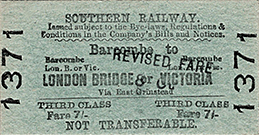
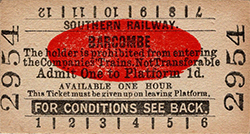
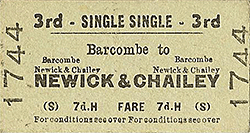
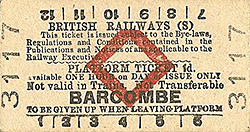
c1904)old1.jpg) A rather splendid view of Stroudley Class B1 No. 185 'George.A.Wallis' pausing at Barcombe with a Down passenger train. The locomotive livery appears to be that introduced in 1905; umber against dark umber with black boiler bands and gilt (gold) lining and name. The brass cabside numberplate probably had blue background and letter infill. Then then incumbent Locomotive & Carriage Superintendent, Douglas Earle Marsh, began a locomotive de-naming policy in 1906 which affected most members of the class. When No. 185 was de-named is not clear but we can deduce that this photograph dates from within a few years subsequent to 1905. The device just ahead of the cab is a Westinghouse air brake pump. The class was named, somewhat untidily, after various persons of note and places served by the LB&SCR. George.A.Wallis (note the full stop between 'George' and 'A' which was common practice at the time) is thought to have been George Augustus Wallis. Born in Merton (now a London suburb) in 1761, Wallis was an artist who spent much of his life in mainland Europe. He died in Florence, Italy, in 1847. Locomotive No. 185 was new ex-Brighton Works in September 1889. She was withdrawn in February 1923 and the entire class had been withdrawn by 1933, the final member going in September of that year. One, however, was to survive into preservation. This is No. 214 "Gladstone", by which name the entire class if often known, new in 1882 as the first class member and withdrawn as Southern Railway No. B214 in 1927. The 'B' prefix was a Southern Railway addition denoting Brighton Works which was responsible for so-lettered locomotives but was never applied to No. 185.
A rather splendid view of Stroudley Class B1 No. 185 'George.A.Wallis' pausing at Barcombe with a Down passenger train. The locomotive livery appears to be that introduced in 1905; umber against dark umber with black boiler bands and gilt (gold) lining and name. The brass cabside numberplate probably had blue background and letter infill. Then then incumbent Locomotive & Carriage Superintendent, Douglas Earle Marsh, began a locomotive de-naming policy in 1906 which affected most members of the class. When No. 185 was de-named is not clear but we can deduce that this photograph dates from within a few years subsequent to 1905. The device just ahead of the cab is a Westinghouse air brake pump. The class was named, somewhat untidily, after various persons of note and places served by the LB&SCR. George.A.Wallis (note the full stop between 'George' and 'A' which was common practice at the time) is thought to have been George Augustus Wallis. Born in Merton (now a London suburb) in 1761, Wallis was an artist who spent much of his life in mainland Europe. He died in Florence, Italy, in 1847. Locomotive No. 185 was new ex-Brighton Works in September 1889. She was withdrawn in February 1923 and the entire class had been withdrawn by 1933, the final member going in September of that year. One, however, was to survive into preservation. This is No. 214 "Gladstone", by which name the entire class if often known, new in 1882 as the first class member and withdrawn as Southern Railway No. B214 in 1927. The 'B' prefix was a Southern Railway addition denoting Brighton Works which was responsible for so-lettered locomotives but was never applied to No. 185.